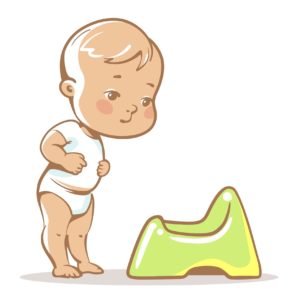In the U.S., potty training is often introduced to kids between 18-36 months of age. This rite of passage is a big deal for both children and their parents. For toddlers, wearing “big kid” underwear is a sign that they’ve “arrived.” For parents, ditching the diapers means freedom from lugging around overstuffed diaper bags and cleaning up gag-inducing messes.
Potty training, however, is often easier said than done. Some children (boys, I’m looking at you) take their sweet time to get the hang of potty training, while others get the pee part down but refuse to poop in the potty. A small percentage of kids even develop a morbid fear of toilets and start to withhold their poop.
Get Wise below about Potty-Training Readiness, Commonly-Asked Questions About Potty Training, Tips for Potty Training, and Pitfalls to Avoid.
Potty-Training Readiness

The first step in potty training is assessing your child’s “potty-training readiness.”
Insider Info: Potty-training readiness varies between cultures and households.
Here are the Top Signs that Your Child is Ready to Start Potty Training:
He/She:
- Tells you when he/she has to go to the bathroom. This signals that your child is beginning to “sense” when he/she has to “go.”
- Asks to use the toilet. This is a sign that your kiddo is into the whole toilet thing.
- Wants to try big-kid underwear.
- Stays dry for several hours at a time.
- Wants to be changed right away when he/she has a wet or dirty diaper.
- Hides in a corner when he/she poops. This suggests that your child is becoming aware of the need for a diaper change and isn’t super psyched about it.
- Is able to follow simple directions and is getting the hang of pulling his/her pants down.
The Nuts & Bolts of Potty Training
Common Potty-Training Questions

How Long Does Potty Training Take?
On average, it takes kids 6 months to achieve daytime bladder and bowel control.
What About the Potty-Training Programs That Claim Success in Just 3 Days?! Although kids can get the concept of potty training down in 3 days, it usually takes longer than that to fully potty train a child during the day.
How Long Does it Take for Kids to be Potty Trained at Night, Too?
Staying dry during the night comes more slowly than staying dry during the day. Because of this, the two are considered separate developmental milestones.
While most kids in the U.S. achieve full daytime bladder and bowel control by 24-48 months, docs give kids at bit longer (until 5 years of age) to stop wetting the bed at night.
PediaTrivia: Bedwetting remains a problem in 15% of 5-year-olds.1
PediaTip: When you first start potty training your toddler, you can float the idea of “nighttime underwear” and use a pull-up until he/she gains more bowel and bladder control at night.
I’ve Heard that Boys are Harder to Potty Train than Girls. Is that True?
Pretty much. When it comes to potty training, boys tend to lag behind girls by 2-3 months. In addition, first-born children take longer to master potty training than their younger siblings.
Now, Let’s Turn Our Attention to the Top 10 Tips for Potty Training Success. Here Goes…

1. As Mentioned Above, Make Sure That Your Child is Ready to Start Potty Training.
Potty training takes longer if it’s started too early.
2. Choose a Low-Stress Time to Introduce Potty Training.
For example, think twice about initiating potty training right before a sibling is born or when a parent is away on a business trip.
3. Slowly Introduce the Concept of Potty Training By Announcing When YOU Have to Go to the Bathroom and By Reading a Book (or Two) to Your Toddler About Kids Learning to Use the Toilet.
PediaWise Picks Include:
- Potty Time! (Daniel Tiger’s Neighborhood Interactive Take-Along Children’s Sound Book) by Scarlet Wing.
- Potty by Leslie Patricelli.
- Where’s the Poop? By Julie Markes.
4. Buy a Bunch of Loose-Fitting Big-Kid Underwear Plus a Potty Seat (To Go on the Toilet) OR a Portable Potty (That You Have to Dump Out After Each Use).
PediaTips:
- Have your child pick out the underwear and choose his/her own potty seat. The more involved your child is in the process, the more invested he/she will be in it.
- If you decide to go the portable potty route, invest in one that makes music or does something cool when your child pees or poops. Positive reinforcement is always a plus!
- If your child is potty training during the summer, you can have him/her run around diaper free and not bother with the underwear. You may feel like you’re playing Russian roulette when you do this, but kids love being naked at this age. Plus, it bypasses the whole pulling-the-underwear-up-and-down thing (which can be tricky for toddlers).
5. Plan for Frequent Potty Breaks (About 10 Times a Day) and Some Messes Along the Way.
6. Have Your Child Sit on the Toilet When He/She Wakes Up, After He/She Eats, and Right Before Bed. Limit the Potty Sitting to 5-10 Minutes at a Time (Any Longer and it Will Start to Feel Like a Chore).
Distract your child with a book or a fun toy that’s reserved for potty training.

7. Offer Praise, a Sticker, or a Small Toy if Your Child Does His/Her Business in the Potty. If He/She Doesn’t Do Anything, Just Say, “No Worries. We’ll Try Again, Later.”
A Word of Caution:

Parents often use candy (think: M&Ms) to reward their children for using the potty. When it comes to potty training, reward systems and reward charts work well, but I often caution parents about rewarding behaviors with edible treats. Why? Because this practice can complicate a child’s relationship with food (think: future emotional eating).
Try This Instead: Fill a box with cheap toys and let your child choose a “prize” each time he/she uses the potty. OR use a reward chart in which your child earns a sticker each time he/she successfully uses the toilet. Once he/she collects a certain number of stickers, then he/she can select a toy. Get Wise(r) about how to set up an effective reward chart here.
8. Make the Process Fun and Pressure-Free.
When it comes to eating, sleeping, and potty training, your child is the one in control. You can’t make your child eat all of his/her broccoli, fall asleep at the snap of your fingers, or use the potty, no matter how much you want to. So be cool, keep it light, and know that potty training takes time and practice.
9. Keep Tabs on Your Child’s Stool.
Constipation can complicate potty training and undermine a child’s success. Kids with hard stools often try to withhold them and don’t want to poop in the potty because it hurts. This can lead to a vicious cycle of refusing to poop, becoming more constipated as a result, and then REALLY not wanting to poop in the potty. Signs that your child is “withholding” include:
- Denying that he/she needs to poop even though it looks like he/she does.
- Trying to hold the poop IN by crossing his/her legs, walking on his/her tiptoes, grunting, turning red, and squatting in the corner.
If Your Child Has Constipation Issues, Try to Get His/Her Stools SOFT Before You Attempt to Potty Train Him/Her. You Can Do This By:
- Increasing the fiber in your child’s diet by serving him/her more fruits, veggies, and whole grains.
- Decreasing the amount of milk that your child drinks if he/she is chugging more than 24 ounces a day.
- Giving your kiddo a stool softener (like Miralax) if his/her pediatrician says it’s OK.
10. Try the Cheerios Trick With Boys. When your son practices standing up to pee, help him improve his accuracy by throwing a couple of Cheerios in the toilet and having him hit them with his urine stream.
Note: This works for husbands who need a little work in the “aim” department, as well.
The Bottom Line
Have fun and good luck. If the potty training doesn’t go well, consider shelving it for a few weeks (or more), and reintroducing it when your child is a bit older. Although potty training does take some work, it shouldn’t be torture. If your child is really struggling with it or is developing “withholding behavior,” ask his/her pediatrician to weigh in on the situation.





